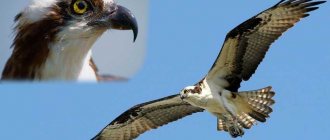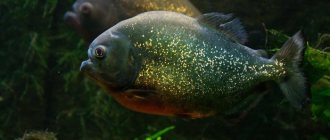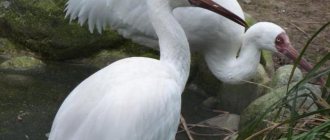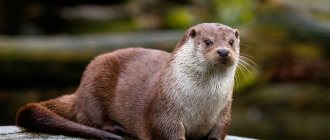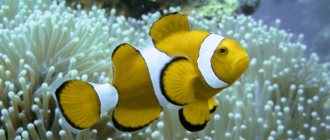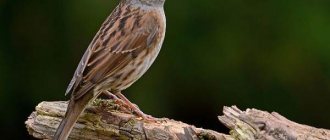The genus of true thrushes includes many amazing birds. In general, there are more than 65 species of thrushes in all corners of our planet, of which 15 are found in Russia.
Blackbirds are migratory birds that change location depending on the time of year. These are small birds, mostly dark in color, agile and jumping.
They have a small body and a short beak; thrushes can vary greatly in weight. Blackbirds have powerful short legs and move along the ground by jumping.
Behavior and lifestyle
Based on the description, birds such as thrushes are busy and restless birds with a difficult character. In any incomprehensible situation, the bird begins to become stressed, the thrush begins to scream frequently and shrilly. In a calm environment, blackbirds are quite quiet and calm, people often do not even notice them.
Despite the fact that blackbirds are migratory birds, they are not always in a hurry to make the migration, and sometimes they can even stay for the winter in a fruitful year and a warm winter. Also, some blackbirds fly away for the winter alone, fighting off the flock.
Birds live and raise their offspring in nests, which they build in tree branches and on stumps, sometimes even on the ground if there are no predators in the immediate area.
Note!
- Parrot: tips for choosing, the best breeds and rules for training different types of parrots (100 photos)
Eagle bird: description, species, lifestyle, habitat and interesting facts about the bird of prey (95 photos)
Parrot cage - features of choice
Reproduction
Birds reach sexual maturity at the age of 1 year. They begin to reproduce at the age of two. Blackbirds are mostly monogamous, forming pairs for one season. During the nesting season they can give birth to 1–2 broods.
The period of egg laying is extended over time. If the clutch is lost, the eggs are laid again. As a result, nests often contain chicks of different ages, including unhatched ones. The nesting period is directly dependent on the habitat. For example, the fieldfare thrush lays eggs from April to September. To attract females, the blackbird (male) bird begins to sing. The sounds are intended to encourage chicks to fly out of the nest, as well as to protect the area where the birds feed.
Thrush nests are cup-shaped. They weave them from reeds, ferns, various roots, use moss, tree bark, branches, straw. They are usually built low, at a level of 1 - 4 m from the ground surface. Near human habitation, blackbirds can place nests quite high, up to 25 m.
When people or dangerous animals appear near the nests, the males begin to circle near the nest with alarming cries, involuntarily indicating its location.
It has been established that these birds prefer to make nests in the following places:
- tree hollows;
- along the cliffs of ravines and rivers;
- on the rocks;
- in old crows' nests;
- in bushes;
- in dead wood;
- directly on the ground.
Usually the nest is built by the female, but the male can also take part in this as much as possible. They fasten plant building material with wet clay, earth, rotten wood, and cobwebs. The inner surface of the nest is lined with moss, pine needles, soft leaves, and feathers. However, there may also be nests without any lining. Blackbirds build a nest within a week, after which they allow it to dry out for another couple of days.
The female lays 2 - 8 eggs. They are mostly turquoise or aquamarine in color. Eggs with olive, red-green, black, and brown spots are often found. They can be completely white or plain. Basically, the coloring is associated with the habitat of the birds and is intended to camouflage the laying of eggs.
The incubation period is about 2 weeks. The female does the incubation, but in some species males can replace her. During this period, the male does not bring food to the female; he only provides protection for the nest. As a result, she leaves the nest only during feeding. Here is a photo of thrush birds, a male and a female are caring for their offspring. Look how touching they are.
Nutrition
Blackbirds are omnivorous birds, their diet varies depending on the season and habitat. In warm weather, these species move closer to people’s homes, gardens and vegetable gardens, which sometimes becomes a big headache for the owners, who can lose a significant part of the harvest.
Thrushes feed on seeds, rosehips and hawthorns, rowan berries, butterflies, earthworms, caterpillars, other insects and their larvae, snails; they can also eat berries such as cherries, strawberries, cherries, and honeysuckle.
Thrush feeding
Whitebrows are not picky and feed on a variety of insects and worms. They don't disdain butterflies either. Adults feed the chicks with worms, bringing them in their beaks several at a time, so that everyone gets a worm.
If the year for rowan is fruitful, then the rowan thrushes do not leave their native places. But although they love berries, they also do not refuse other plants and insects.
In the winter season, it is difficult for birds to get to the ground to search for food, so in frosty weather they feed only on rowan berries and some shrubs, for example, rose hips and hawthorn.
In autumn, he enjoys consuming various fruits. Fieldfares look for insects even in freshly plowed fields. You can often see them in large flocks carefully inspecting the ground, literally every centimeter.
The blackbird is the most unpretentious bird in terms of food and can always find it. His favorite treat, of course, is worms. In most cases, he finds food right on the ground.
If you watch a blackbird in the summer, you can see how it jumps through the grass in search of worms. Tilting his head to the side, he looks out for prey, and then deftly pulls it out. Blackbirds often feast on berries and fruits. They receive the required amount of fluid with food.
Song thrushes have a varied diet, and what they eat even depends on the time of year and weather conditions. When the snow melts in the spring, but the ground is still damp, they catch worms.
In late spring and early summer, their diet includes caterpillars, which are later replaced by worms again. When summer comes to an end, they eat various seeds and fruits. This is how they accumulate the necessary energy before flying south. Throughout the year, song thrushes also eat snails by breaking their shells on rocks.
Blackbird
The name of this species speaks for itself. The plumage of the birds is almost completely black, with rufous areas and a bright beak. But against the background of coal males, the females look still colorful.
Blackbirds are very cautious birds, they love solitude and prefer to settle at a distance from their own species. This species lives in Europe and southwest Russia. Blackbirds nest either high in the treetops or near the ground.
The blackbird is also known as a stunning singer.
Appearance of blackbirds and their distribution
Blackbirds are relatively small birds. Depending on the species, these creatures can reach 20-25 cm in length. Body weight usually ranges from 100 to 180 g. All representatives of the thrush family are characterized by a short beak of gray or bright yellow color. The eyes are usually black. Most species of these birds are distinguished by their modest plumage color.
For example, the most common songbird or gray thrush in Russia has a chocolate-gray head and back. The sides of the bird are usually yellowish. The breast is lighter in color with brown spots. Representatives of both sexes have plumage similar in color.
DIGITAL CAMERA
The blackbird is no less common than the songbird. Females forced to stay in the nest for a long time have a very mild grayish-beige plumage color. It allows the bird to remain invisible to natural enemies. Males of this species are similar in appearance to jackdaws. The black plumage is probably necessary for the bird to impress its mate during the breeding season.
The blackbird's image is complemented by its bright orange beak. This coloring remains with the bird all year round.
Relatively recently, these creatures settled exclusively in clean forest thickets, but now they can be found in well-groomed park areas, where they can find the required amount of food
The Pied Thrush lives up to its name exclusively during the breeding season. At this time, males acquire bright plumage. In birds at this time, the head is grey-blue, the abdomen and tail are orange, and there is a white stripe on the back. During the winter, they change their plumage and begin to resemble females, characterized by modest gray-gray plumage.
Deryaba
This species is notable for its long tail and the lack of color differences between females and males. The birds have a white belly and wings on the inside, the main plumage is pale brown, the feathers are strewn with small spots.
The species is found in Central Europe, as well as in the southern regions during the winter.
Mistletoes nest in the forks of high, fairly thick and strong branches.
Description and features of the blackbird
The blackbird in the photo has a metallic cast. The bird's iris and beak are orange. Such photographs are attached to most articles, justifying the name of the species. However, the females in it are brown. The abdomen and chest of females are especially light. Their tail is almost black.
Male blackbird
The breast of females of the species has transverse markings. Young males also have them. Before reaching sexual maturity, they have a color similar to females. The spots on the chest and brown coloration are features of the song thrush. Females and young animals of the black species are often confused with it. As an adult, it is twice the size of a sparrow, reaches 26 centimeters in length, and weighs 80-110 grams.
The description of the bird also includes the singing of a blackbird . It is sonorous, composed of sounds similar to those extracted from a flute. The melody is minor, unhurried. The set of sounds in the song of a blackbird is varied.
Listen to the voice of the blackbird
"Aria" does not have a specific length. This also characterizes the performances of the song thrush, but it often repeats musical words. The voice of the hero of the article also resembles the singing of Dryaba, but with uncalibrated pauses and a lower pitch.
Female blackbird
The twitter of the hero of the article is one of the fragments of the Beatles composition. The song is included in the “White Album”, recorded in 1968. At that time, Paul McCartney was the only vocalist, playing acoustic.
The style of singing is the same in all 14 subspecies of blackbird. They differ in size, beak structure, and color nuances. The Richmond subspecies, for example, reaches a maximum length of 26 centimeters. The bird also has a thicker beak than the representatives of the nominate species and has a rusty reflection on the chest.
Some subspecies of blackbird are endemic to certain regions. Thus, Azorensis lives in the Azores Islands. Representatives of the subspecies are more glossy and shiny than ordinary blackbirds. But the subtype Bourdiloni has lance-brown males and almost beige females. Representatives of the subspecies live in southern India.
For most, species identity is the mystery of the blackbird . That, by the way, is the name of the Soviet detective story released in 1983. The film is based on the novel by Agatha Christie. The book, however, has a different name - “A Pocket Full of Rye.” It is just as difficult for a non-ornithologist to understand the intricacies of the plot as it is for a non-ornithologist to understand the differences between the subspecies of blackbirds.
White-throated Blackbird
These birds are also called wood rock thrushes. The white-throated blackbird is distinguished by its miniature size. It has a deep blue back and a red belly, and a neat white spot on its neck.
This species can be found in the eastern part of Russia, not south of Transbaikalia. Birds nest at a distance from their relatives.
This species is also known for its singing talent.
Appearance and features
Photo: Bird Thrush Fieldfare
Even those who are poorly versed in bird trills will easily be able to distinguish the fieldfare from other representatives of the thrush class. This happens due to the unique colorful appearance of the individual.
The external characteristics of migratory animals can be presented as follows:
- color – multi-color. The birds' heads are usually grayish. The tail is so dark that it appears black. The back is colored brown. The belly (like many other thrushes) differs from the background of the general color - it is white. There is a dark yellow apron in small spots on the brisket. The wing lining (noticeable when the bird is flying) is white;
- Dimensions – average. Fieldfares are significantly inferior in size to jackdaws, but at the same time superior to starlings. In terms of size characteristics, they are almost identical to the blackbird. Maximum weight – 140 g (male) and 105 g (female). The body length of adult individuals barely reaches 28 cm. The wingspan is quite wide - about 45 cm;
- the beak is sharp. Compared to other birds, the fieldfare stands out from its bright yellow, sharp beak. Its top is dark. The length of the beak ranges from 1.5 to 3 cm. This length is quite enough to absorb small insects and eat the fruits of the rowan tree.
Interesting fact: The color of males and females is practically the same. The only distinctive characteristic is the dimensions of the representatives of fieldfare.
With seasonal climate changes, the appearance of fieldfares remains virtually unchanged. Only the color of the beak changes (from bright yellow to ocher), and the reddish apron located on the chest of the individual also increases.
Red-headed blackbird
This species could be called inconspicuous due to its almost uniform brown color, if not for the brown or gray tan markings beautifully located throughout the abdomen.
The main habitat is Central and Eastern Siberia.
Red-headed blackbirds nest in low trees or bushes.
Where does the fieldfare thrush live?
Photo: Fieldfare in Russia
Today you can meet fieldfares throughout northern Eurasia (from Cape Roka to Cape Dezhnev). Birds lead both sedentary and nomadic lifestyles.
In winter, most individuals prefer to spend time in the following countries:
- North Africa is a part of Africa, which includes countries such as Egypt, Sudan, Libya, etc. This region attracts birds with its Mediterranean natural zone. Most of the territory is occupied by the Sahara.
- Europe (Central and Southern) is a region that includes Mediterranean countries, as well as states that are not part of the CIS. The territory is characterized by a calm climate, fertile soil and an abundance of plants (which is extremely necessary for the normal life of field thrushes).
- Asia is an island part (mainly Türkiye). The climatic conditions of the area are mountainous and have features of a continental climate. In the Aegean and Mediterranean Seas, winter is quite mild and calm.
Birds also live in the CIS countries. Moreover, with a sufficient number of rowan bushes, they may not fly away to winter in foreign territories at all. Fieldfare like to settle in overgrown steppes, forests and their edges. The main requirement for a place of residence is the proximity of wet meadows. You won't be able to meet these birds in a deep forest. Nesting for blackbirds takes several months (from April to July).
Interesting fact: Fieldfare build nests mainly on pines, alders, and oaks at the fork of a trunk. All components that come under the beak (moss, twigs) act as building materials. The binding agent is clay, silt, and wet soil. The result of the work is a massive cup-shaped structure with a fairly deep bottom.
Getting to the fieldfare nest is not so easy. Birds build their home at considerable heights. The maximum level of construction of the structure is 6 m.
Habitat
Birds of the thrush family prefer to settle in forests, but in the modern world they can be found in city parks and squares, where it is easier for them to obtain suitable food.
Most thrushes live in Europe and America, and are also found in Asia. During wintering, birds can fly to Africa, but only to its northern regions, since the very hot climate is not suitable for blackbirds.
In Russia, blackbirds are found in almost every corner, not only in forests and near people, but also in the steppes. Blackbirds are light-loving, so they prefer to settle near deciduous trees.
The choice of location is also greatly influenced by the availability and number of plants and insects suitable for food.
Origin of the species and description
Photo: Blackbird
The blackbird can be called one of the largest blackbirds. This bird can reach a length of twenty-six centimeters, and its weight ranges from eighty to one hundred and twenty-five grams. It is not difficult to recognize this bird. Most males are painted a very bright black color, without a shimmer, so blackbirds are rarely confused with crows. Young blackbirds and females have brown plumage.
Video: Blackbird
A very interesting fact is that among blackbirds there are albinos. They stand out very much from other birds. Albino thrushes have recently begun to actively increase their presence in cities. This had a positive effect on their population size. If in the wild such birds are of interest only to hunters, then in urban conditions they attract individuals of the opposite sex.
Interesting fact: Few people know that the blackbird is an excellent singer. But he sings only at certain times of the day - at sunrise and sunset. His voice and melodies are very reminiscent of elegant flute playing.
Blackbirds are a type of blackbird. They are part of the thrush family, a large order of passerines. Today there are many different subspecies of these birds.
The most common ones can be identified:
- m. merula Linnaeus. This subspecies is very widely represented in Europe, and was also specially brought to New Zealand and Australia. Such birds are distinguished by a very thin beak and a bright rusty color in the chest area;
- m. Intermedius. Found in Russia, Tajikistan, Afghanistan, and China. The birds have dark black feathers, massive beaks, and larger dimensions than other subspecies;
- m. mauretanicus Hartert. These blackbirds live only in China.
Interesting fact: In Europe, blackbirds are more friendly. They associate these birds with Saint Kevin, who is famous for his kind heart. If such blackbirds settle near a house, then Europeans consider this a very favorable sign.
Fight for territory
Most often, blackbirds have to protect their nests and chicks from crows who try to destroy the nest or steal the eggs. Squirrels, owls and hawks also pose a threat to birds.
Blackbirds are excellent protectors not only for their offspring, but also for other bird species, such as finches, which settle closer to the blackbirds.
Offspring and populations
Blackbirds are polygamous birds that mate for only one season. Males produce stunningly beautiful trills to attract females. Once a pair is found, they begin building a small nest from twigs and twigs.
The nest is made in hollows, branch forks, stumps, and sometimes just on the ground. The outside of the nest is reinforced with clay, and the inside surface is covered with moss, down and small feathers.
Typically, thrushes lay one or two clutches per season; each clutch can contain up to six small eggs. The female incubates the egg for an average of two weeks.
The chicks have excellent metabolism and grow very quickly, but despite all the efforts of their parents, not all survive to fly out of the nest. This event occurs in the second week of life of little blackbirds. Parents take care of the chicks until they become completely independent.
Thrush populations are quite numerous, most species gather in fairly large flocks, but there are also those who prefer solitude. Blackbirds live more than 15 years.
Behavior of blackbirds in the natural environment
In their natural environment, these birds pair only for one season. The birds arrive at their nesting sites at the end of April, when the weather is warm enough for them. The males attract the female with their beautiful singing, which can be heard for several kilometers in the forest thicket. After pairing, the birds work together to build a home for future chicks.
Typically, nests are arranged:
- in tree hollows;
- on bumps;
- stumps;
- branchy bush.
On rare occasions, bird nests can be seen on the ground. Typically, thrushes try to settle along floodplains of rivers, as well as near small clearings, where they can find more food.
The nest of these birds is usually small. Birds weave it from small twigs. The inside of the nest is always reinforced with clay. Inside it is lined with last year's soft grass. Often, when building a nest, birds use soft moss, fluff, small roots, etc.

